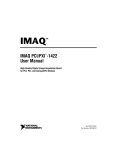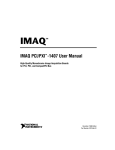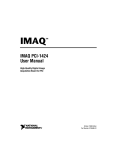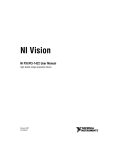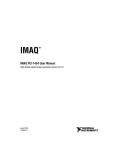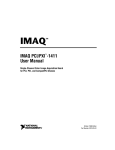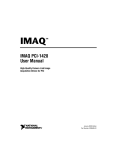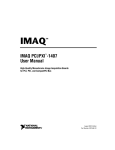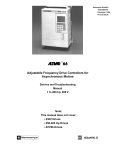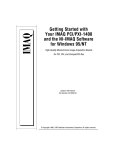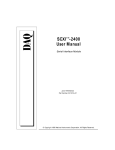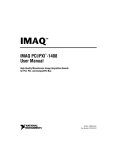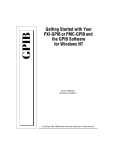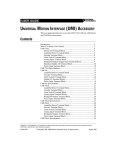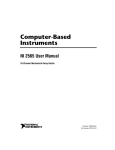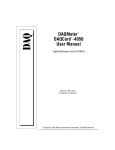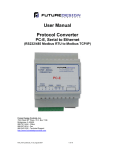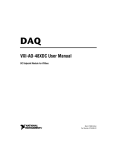Download IMAQ PCI/PXI-1422 User Manual
Transcript
IMAQ TM IMAQ PCI/PXI-1422 User Manual High-Quality Digital Image Acquisition Board for PCI, PXI, and CompactPCI Chassis IMAQ PCI/PXI-1422 User Manual January 1999 Edition Part Number 322158A-01 Worldwide Technical Support and Product Information http://www.natinst.com National Instruments Corporate Headquarters 11500 North Mopac Expressway Austin, Texas 78759 USA Tel: 512 794 0100 Worldwide Offices Australia 03 9879 5166, Austria 0662 45 79 90 0, Belgium 02 757 00 20, Brazil 011 284 5011, Canada (Ontario) 905 694 0085, Canada (Québec) 514 694 8521, Denmark 45 76 26 00, Finland 09 725 725 11, France 0 1 48 14 24 24, Germany 089 741 31 30, Hong Kong 2645 3186, India 91805275406, Israel 03 6120092, Italy 02 413091, Japan 03 5472 2970, Korea 02 596 7456, Mexico (D.F.) 5 280 7625, Mexico (Monterrey) 8 357 7695, Netherlands 0348 433466, Norway 32 84 84 00, Singapore 2265886, Spain (Madrid) 91 640 0085, Spain (Barcelona) 93 582 0251, Sweden 08 587 895 00, Switzerland 056 200 51 51, Taiwan 02 2377 1200, United Kingdom 01635 523545 For further support information, see the Technical Support Resources appendix of this manual. © Copyright 1999 National Instruments Corporation. All rights reserved. Important Information Warranty The PCI-1422 and PXI-1422 are warranted against defects in materials and workmanship for a period of 1 year from the date of shipment, as evidenced by receipts or other documentation. National Instruments will, at its option, repair or replace equipment that proves to be defective during the warranty period. This warranty includes parts and labor. The media on which you receive National Instruments software are warranted not to fail to execute programming instructions, due to defects in materials and workmanship, for a period of 90 days from date of shipment, as evidenced by receipts or other documentation. National Instruments will, at its option, repair or replace software media that do not execute programming instructions if National Instruments receives notice of such defects during the warranty period. National Instruments does not warrant that the operation of the software shall be uninterrupted or error free. A Return Material Authorization (RMA) number must be obtained from the factory and clearly marked on the outside of the package before any equipment will be accepted for warranty work. National Instruments will pay the shipping costs of returning to the owner parts which are covered by warranty. National Instruments believes that the information in this document is accurate. The document has been carefully reviewed for technical accuracy. In the event that technical or typographical errors exist, National Instruments reserves the right to make changes to subsequent editions of this document without prior notice to holders of this edition. The reader should consult National Instruments if errors are suspected. In no event shall National Instruments be liable for any damages arising out of or related to this document or the information contained in it. EXCEPT AS SPECIFIED HEREIN, NATIONAL INSTRUMENTS MAKES NO WARRANTIES, EXPRESS OR IMPLIED, AND SPECIFICALLY DISCLAIMS ANY WARRANTY OF MERCHANTABILITY OR FITNESS FOR A PARTICULAR PURPOSE. CUSTOMER’S RIGHT TO RECOVER DAMAGES CAUSED BY FAULT OR NEGLIGENCE ON THE PART OF NATIONAL INSTRUMENTS SHALL BE LIMITED TO THE AMOUNT THERETOFORE PAID BY THE CUSTOMER. NATIONAL INSTRUMENTS WILL NOT BE LIABLE FOR DAMAGES RESULTING FROM LOSS OF DATA, PROFITS, USE OF PRODUCTS, OR INCIDENTAL OR CONSEQUENTIAL DAMAGES, EVEN IF ADVISED OF THE POSSIBILITY THEREOF. This limitation of the liability of National Instruments will apply regardless of the form of action, whether in contract or tort, including negligence. Any action against National Instruments must be brought within one year after the cause of action accrues. National Instruments shall not be liable for any delay in performance due to causes beyond its reasonable control. The warranty provided herein does not cover damages, defects, malfunctions, or service failures caused by owner’s failure to follow the National Instruments installation, operation, or maintenance instructions; owner’s modification of the product; owner’s abuse, misuse, or negligent acts; and power failure or surges, fire, flood, accident, actions of third parties, or other events outside reasonable control. Copyright Under the copyright laws, this publication may not be reproduced or transmitted in any form, electronic or mechanical, including photocopying, recording, storing in an information retrieval system, or translating, in whole or in part, without the prior written consent of National Instruments Corporation. Trademarks BridgeVIEW™, ComponentWorks™, CVI™, IMAQ™, LabVIEW™, MITE™, NI-DAQ™, NI-IMAQ™, PXI™, and RTSI™ are trademarks of National Instruments Corporation. Product and company names mentioned herein are trademarks or trade names of their respective companies. WARNING REGARDING MEDICAL AND CLINICAL USE OF NATIONAL INSTRUMENTS PRODUCTS National Instruments products are not designed with components and testing intended to ensure a level of reliability suitable for use in treatment and diagnosis of humans. Applications of National Instruments products involving medical or clinical treatment can create a potential for accidental injury caused by product failure, or by errors on the part of the user or application designer. Any use or application of National Instruments products for or involving medical or clinical treatment must be performed by properly trained and qualified medical personnel, and all traditional medical safeguards, equipment, and procedures that are appropriate in the particular situation to prevent serious injury or death should always continue to be used when National Instruments products are being used. National Instruments products are NOT intended to be a substitute for any form of established process, procedure, or equipment used to monitor or safeguard human health and safety in medical or clinical treatment. Compliance FCC/DOC Radio Frequency Interference Class A Compliance This equipment generates and uses radio frequency energy and, if not installed and used in strict accordance with the instructions in this manual, may cause interference to radio and television reception. Classification requirements are the same for the Federal Communications Commission (FCC) and the Canadian Department of Communications (DOC). This equipment has been tested and found to comply with the following two regulatory agencies: Federal Communications Commission This equipment has been tested and found to comply with the limits for a Class A digital device, pursuant to part 15 of the FCC Rules. These limits are designed to provide reasonable protection against harmful interference when the equipment is operated in a commercial environment. This equipment generates, uses, and can radiate radio frequency energy and, if not installed and used in accordance with the instruction manual, may cause harmful interference to radio communications. Operation of this equipment in a residential area is likely to cause harmful interference in which case the user will be required to correct the interference at his own expense. Notices to User: Changes or modifications not expressly approved by National Instruments could void the user’s authority to operate the equipment under the FCC Rules. This device complies with the FCC rules only if used with shielded interface cables of suitable quality and construction. National Instruments used such cables to test this device and provides them for sale to the user. The use of inferior or nonshielded interface cables could void the user’s authority to operate the equipment under the FCC rules. If necessary, consult National Instruments or an experienced radio/television technician for additional suggestions. The following booklet prepared by the FCC may also be helpful: Interference to Home Electronic Entertainment Equipment Handbook. This booklet is available from the U.S. Government Printing Office, Washington, DC 20402. Canadian Department of Communications This Class A digital apparatus meets all requirements of the Canadian Interference-Causing Equipment Regulations. Cet appareil numérique de la classe A respecte toutes les exigences du Règlement sur le matériel brouilleur du Canada. Contents About This Manual Organization of This Manual ...........................................................................................vii Conventions Used in This Manual...................................................................................viii National Instruments Documentation ..............................................................................viii Customer Communication ...............................................................................................ix Chapter 1 Introduction About the PCI/PXI-1422 .................................................................................................1-1 Using PXI with CompactPCI...........................................................................................1-2 What You Need to Get Started ........................................................................................1-3 Software Programming Choices ......................................................................................1-4 National Instruments Application Software ......................................................1-4 NI-IMAQ Driver Software ................................................................................1-5 Optional Equipment .........................................................................................................1-7 Unpacking ........................................................................................................................1-8 How to Set up Your IMAQ System.................................................................................1-8 Chapter 2 Installation Installation .......................................................................................................................2-1 Chapter 3 Hardware Overview Functional Overview........................................................................................................3-1 Differential/TTL Level Converters ...................................................................3-2 LUTs..................................................................................................................3-2 Multiple-Tap Data Formatter ............................................................................3-3 SDRAM.............................................................................................................3-3 Advanced Clock Generation..............................................................................3-3 RS-232 Serial Interface .....................................................................................3-3 Trigger Control and Mapping Circuitry ............................................................3-4 High-Speed Timing ...........................................................................................3-4 Acquisition, Scaling, ROI..................................................................................3-4 Scatter-Gather DMA Controllers ......................................................................3-4 Bus Master PCI Interface ..................................................................................3-4 © National Instruments Corporation v IMAQ PCI/PXI-1422 User Manual Contents Board Configuration NVRAM.......................................................................... 3-5 Video Acquisition ............................................................................................. 3-5 Start Conditions................................................................................................. 3-5 Acquisition Window Control ............................................................................ 3-5 Chapter 4 Signal Connections I/O Connector .................................................................................................................. 4-1 Signal Description ........................................................................................................... 4-3 Appendix A Specifications Appendix B Customer Communication Glossary Index Figures Figure 1-1. Figure 1-2. Figure 1-3. Figure 1-4. IMAQ Vision Builder and Application Development Tools .................. 1-5 NI-IMAQ Functions................................................................................ 1-6 The Relationship between the Programming Environment, NI-IMAQ, and Your Hardware............................................................... 1-7 How to Set up Your IMAQ System ........................................................ 1-9 Figure 3-1. PCI/PXI-1422 Block Diagram ................................................................ 3-2 Figure 4-1. PCI/PXI-1422 Pin Assignments ............................................................. 4-2 Tables Table 1-1. Pins Used by the PXI-1422 Device ........................................................ 1-2 Table 4-1. I/O Connector Signals ............................................................................ 4-3 IMAQ PCI/PXI-1422 User Manual vi © National Instruments Corporation About This Manual The IMAQ PCI/PXI-1422 User Manual describes the features, functions, and operation of the IMAQ PCI-1422 and PXI-1422 devices. The IMAQ PCI-1422 and PXI-1422 devices are universal digital image acquisition (IMAQ) boards designed to acquire images from and control digital cameras. The IMAQ PCI/PXI-1422 User Manual is intended for users with a basic knowledge of image acquisition. Organization of This Manual The IMAQ PCI/PXI-1422 User Manual is organized as follows: • Chapter 1, Introduction, describes the PCI-1422 and PXI-1422; lists what you need to get started; describes software programming choices, optional equipment, and custom cables; and explains how to unpack and set up the PCI/PXI-1422. • Chapter 2, Installation, explains how to install your PCI-1422 or PXI-1422 board. • Chapter 3, Hardware Overview, presents an overview of the hardware functions on your PCI/PXI-1422 board and explains the operation of each functional unit making up the PCI/PXI-1422. • Chapter 4, Signal Connections, describes signal connections for the PCI/PXI-1422. • Appendix A, Specifications, lists the specifications of the PCI/PXI-1422. • Appendix B, Customer Communication, contains forms you can use to request help from National Instruments or to comment on our products and manuals. • The Glossary contains an alphabetical list and description of terms used in this manual, including abbreviations, acronyms, metric prefixes, mnemonics, and symbols. • The Index contains an alphabetical list of key terms and topics in this manual, including the page where you can find each one. © National Instruments Corporation vii IMAQ PCI/PXI-1422 User Manual About This Manual Conventions Used in This Manual The following conventions are used in this manual: <> Angle brackets containing numbers separated by an ellipsis represent a range of values associated with a bit or signal name—for example, DBIO<3..0>. This icon to the left of bold italicized text denotes a note, which alerts you to important information. This icon to the left of bold italicized text denotes a warning, which advises you of precautions to take to avoid being electrically shocked. bold italic Bold italic text denotes a note, caution, or warning. italic Italic text denotes variables, emphasis, a cross reference, or an introduction to a key concept. monospace Text in this font denotes proper names of disk drives, paths, or directories. National Instruments Documentation The IMAQ PCI/PXI-1422 User Manual is one piece of the documentation set for your image acquisition system. You could have any of several types of manuals, depending on the hardware and software in your system. Use the different types of manuals you have as follows: IMAQ PCI/PXI-1422 User Manual • Software documentation—You may have both application software and NI-IMAQ software documentation. National Instruments application software includes LabVIEW, BridgeVIEW, ComponentWorks, and LabWindows/CVI. After you set up your hardware system, use either the application software (LabVIEW, BridgeVIEW, ComponentWorks, or LabWindows/CVI) documentation, or the NI-IMAQ documentation to help you write your application. If you have a large and complicated system, it is worthwhile to look through the software documentation before you configure your hardware. • Accessory installation guides or manuals—If you are using accessory products, read the terminal block and cable assembly installation guides or accessory board user manuals. They explain how to physically connect the relevant pieces of the system. Consult these guides when you are making your connections. viii © National Instruments Corporation About This Manual Customer Communication National Instruments wants to receive your comments on our products and manuals. We are interested in the applications you develop with our products, and we want to help if you have problems with them. To make it easy for you to contact us, this manual contains comment and configuration forms for you to complete. These forms are in Appendix B, Customer Communication, at the end of this manual. © National Instruments Corporation ix IMAQ PCI/PXI-1422 User Manual 1 Introduction This chapter describes the PCI-1422 and PXI-1422; lists what you need to get started; describes software programming choices, optional equipment, and custom cables; and explains how to unpack and set up the PCI/PXI-1422. About the PCI/PXI-1422 The PCI/PXI-1422 is a highly flexible IMAQ board for PCI, PXI, and CompactPCI chassis that supports a diverse range of digital cameras from many camera companies. The PCI/PXI-1422 acquires digital images in real time and can store these images in onboard frame memory, or transfer these images directly to system memory. The board can capture up to 16 bits of data at a time at clock speeds up to 40 MHz. The PCI/PXI-1422 is simple to configure and is factory calibrated so that you can easily install the board and begin acquiring images. The PCI/PXI-1422 ships with NI-IMAQ, the National Instruments complete IMAQ driver software you can use to directly control the PCI/PXI-1422 and other National Instruments IMAQ hardware products. Using NI-IMAQ, you can quickly and easily start your applications without having to program the board at the register level. Featuring a high-speed data flow path, the PCI/PXI-1422 is ideal for both industrial and scientific environments. As a standalone board, the PCI/PXI-1422 supports up to 16 bits of differential video data, four general-purpose control lines that can be configured to generate precise timing signals to control digital camera acquisition, and four external input/output (I/O) lines that you can use as triggers or as high-speed digital I/O lines. If you require more advanced triggering or digital I/O lines (either digital or analog), you can use the PCI/PXI-1422 and NI-IMAQ with the National Instruments data acquisition (DAQ) product line. A common problem with image acquisition boards is that you cannot easily synchronize several functions to a common trigger or timing event. The PCI/PXI-1422 uses its Real-Time System Integration (RTSI) bus to solve this problem. The RTSI bus consists of the National Instruments RTSI bus interface and ribbon cable to route additional timing and trigger signals © National Instruments Corporation 1-1 IMAQ PCI/PXI-1422 User Manual Chapter 1 Introduction between the PCI/PXI-1422 and up to four National Instruments DAQ or IMAQ boards in your computer. The RTSI bus can even synchronize multiple IMAQ hardware captures. Detailed specifications of the PCI/PXI-1422 are in Appendix A, Specifications. Using PXI with CompactPCI Using PXI-compatible products with standard CompactPCI products is an important feature provided by the PXI Specification, Revision 1.0. If you use a PXI-compatible plug-in device in a standard CompactPCI chassis, you will be unable to use PXI-specific functions, but you can still use the basic plug-in device functions. For example, the RTSI bus on your PXI-1422 device is available in a PXI chassis, but not in a CompactPCI chassis. The CompactPCI specification permits vendors to develop sub-buses that coexist with the basic PCI interface on the CompactPCI bus. Compatible operation is not guaranteed between CompactPCI devices with different sub-buses nor between CompactPCI devices with sub-buses and PXI. The standard implementation for CompactPCI does not include these sub-buses. Your PXI-1422 device will work in any standard CompactPCI chassis adhering to the PICMG 2.0 R2.1 CompactPCI core specification using the 64-bit definition for J2. PXI-specific features are implemented on the J2 connector of the CompactPCI bus. Table 1-1 lists the J2 pins your PXI-1422 device uses. Your PXI device is compatible with any CompactPCI chassis with a sub-bus that does not drive these lines. Even if the sub-bus is capable of driving these lines, the PXI device is still compatible as long as those pins on the sub-bus are disabled by default and not ever enabled. Damage may result if these lines are driven by the sub-bus. Table 1-1. Pins Used by the PXI-1422 Device IMAQ PCI/PXI-1422 User Manual PXI-1422 Signal PXI Pin Name PXI J2 Pin Number RTSI Trigger (0..6) PXI Trigger (0..6) B16, A16, A17, A18, B18, C18, E18 1-2 © National Instruments Corporation Chapter 1 Introduction What You Need to Get Started To set up and use your PCI/PXI-1422, you will need the following: ❑ One of the following 1422 devices: – PCI-1422 – PXI-1422 ❑ Set up and Test the PCI/PXI-1422 ❑ IMAQ PCI/PXI-1422 User Manual ❑ NI-IMAQ for Windows 95/98/NT Release Notes ❑ NI-IMAQ for Windows 95/98/NT and documentation ❑ Optional software packages and documentation: – LabVIEW – BridgeVIEW – LabWindows/CVI – IMAQ Vision for G – IMAQ Vision for LabWindows/CVI – ComponentWorks IMAQ Vision – IMAQ Vision Builder ❑ IMAQ D100 series camera cables, depending on your camera ❑ IMAQ D2504 video cable (optional—for access to trigger lines) ❑ Your Pentium-based PCI computer running Windows 95, Windows 98, or Windows NT ❑ A digital video camera © National Instruments Corporation 1-3 IMAQ PCI/PXI-1422 User Manual Chapter 1 Introduction Software Programming Choices You have several options to choose from when programming your National Instruments IMAQ hardware. You can use National Instruments application software such as LabVIEW, BridgeVIEW, and LabWindows/CVI; National Instruments image analysis software such as IMAQ Vision; the ComponentWorks IMAQ Vision collection of ActiveX controls; or the NI-IMAQ driver software. National Instruments Application Software LabVIEW and BridgeVIEW feature interactive graphics, a state-of-the-art user interface, and a powerful graphical programming language, G. The NI-IMAQ VI Library for G, a series of virtual instruments (VIs) for using LabVIEW and BridgeVIEW with the PCI/PXI-1422, is included with the NI-IMAQ software kit. The NI-IMAQ VI Library for G is functionally equivalent to the NI-IMAQ software. LabWindows/CVI features interactive graphics, a state-of-the-art user interface, and uses the ANSI standard C programming language. The LabWindows/CVI IMAQ Library, a series of functions for using LabWindows/CVI with the PCI/PXI-1422, is included with the NI-IMAQ software kit. The LabWindows/CVI IMAQ Library is functionally equivalent to the NI-IMAQ software. IMAQ Vision for G is an image acquisition, processing, and analysis library that consists of more than 400 VIs for using the PCI/PXI-1422 with LabVIEW and BridgeVIEW. You can use IMAQ Vision for G functions directly or in combination for unique image processing. There are two versions of IMAQ Vision for G. The Base version gives you the ability to acquire, display, manipulate, and store images. The Advanced version is a complete set of functions for image analysis, processing, and interpretation. Using IMAQ Vision for G, an imaging novice or expert can perform graphical programming of the most basic or complicated image applications without knowledge of any algorithm implementations. IMAQ Vision for LabWindows/CVI is an image acquisition and analysis library consisting of a series of routines for using the PCI/PXI-1422 with LabWindows/CVI. IMAQ Vision for LabWindows/CVI brings the same functionality to LabWindows/CVI as IMAQ Vision for G does for LabVIEW and BridgeVIEW. IMAQ PCI/PXI-1422 User Manual 1-4 © National Instruments Corporation Chapter 1 Introduction ComponentWorks IMAQ Vision is an image acquisition, processing, and analysis library for use in Visual Basic, Visual C++, Borland Delphi, and Microsoft Internet Explorer. ComponentWorks IMAQ Vision brings the same functionality to ComponentWorks as IMAQ Vision for G does for LabVIEW and BridgeVIEW. The ComponentWorks IMAQ hardware interface control, an ActiveX control for controlling IMAQ devices, is included with the NI-IMAQ software kit. The ComponentWorks IMAQ hardware interface control is functionally equivalent to the NI-IMAQ software. IMAQ Vision Builder is an interactive prototyping tool for machine vision and scientific imaging developers. With IMAQ Vision Builder, you can prototype vision software quickly or test how various vision image processing functions work. As shown in Figure 1-1, IMAQ Vision Builder generates a text description—a recipe of the machine vision and image processing functions. This description file provides a guide for developing applications with IMAQ Vision in LabVIEW, BridgeVIEW, LabWindows/CVI, and ComponentWorks. IMAQ™ Vision Builder Prototype Builder File Vision Application Development IMAQ Vision and Application Software Figure 1-1. IMAQ Vision Builder and Application Development Tools NI-IMAQ Driver Software The NI-IMAQ driver software is included at no charge with the PCI/PXI-1422. NI-IMAQ has an extensive library of functions that you can call from your application programming environment. These functions include routines for video configuration, image acquisition (continuous and single-shot), memory buffer allocation, trigger control, and board configuration, as shown in Figure 1-2. © National Instruments Corporation 1-5 IMAQ PCI/PXI-1422 User Manual Chapter 1 Introduction NI-IMAQ Image Acquisition Triggering and Timing DAQ Synchronization Buffer Control Camera Control Look-up Table Control Figure 1-2. NI-IMAQ Functions The NI-IMAQ driver software performs all functions required for acquiring and saving images. The NI-IMAQ software does not perform any image analysis. For image analysis functionality, refer to the National Instruments Application Software section earlier in this chapter. NI-IMAQ has both high-level and low-level functions for maximum flexibility and performance. Examples of high-level functions include the functions to acquire images in single-shot or continuous mode. An example of a low-level function is configuring an image sequence since it requires advanced understanding of the PCI/PXI-1422 and image acquisition. NI-IMAQ also internally resolves many of the complex issues between the computer and the PCI/PXI-1422, such as programming interrupts and DMA controllers. NI-IMAQ is the interface path between LabVIEW, BridgeVIEW, LabWindows/CVI, or a conventional programming environment and the PCI/PXI-1422. Any platform that supports NI-IMAQ also supports NI-DAQ and a variety of National Instruments DAQ boards, so your PCI/PXI-1422 and NI-IMAQ development can integrate with National Instruments DAQ products. Whether you are using conventional programming languages or National Instruments software, your application uses the NI-IMAQ driver software, as illustrated in Figure 1-3. IMAQ PCI/PXI-1422 User Manual 1-6 © National Instruments Corporation Chapter 1 Introduction Vision Software IMAQ Vision Image Analysis Blob Analysis Color Analysis Filters Gauging and Measurement Correlation Display and ROI Morphology Application Software LabVIEW BridgeVIEW ActiveX LabWindows/CVI (ComponentWorks) Driver Software NI-IMAQ NI-DAQ ValueMotion/ FlexMotion Hardware IMAQ NI-DAQ ValueMotion/ FlexMotion Figure 1-3. The Relationship between the Programming Environment, NI-IMAQ, and Your Hardware Optional Equipment National Instruments offers a variety of products for use with your PCI/PXI-1422, including the following cables and other National Instruments products: • Cables to connect your digital camera to the PCI/PXI-1422 • A four-pod BNC cable, which routes trigger signals to a BNC connector block (IMAQ D2504) © National Instruments Corporation 1-7 IMAQ PCI/PXI-1422 User Manual Chapter 1 Introduction • RTSI bus cables for connecting the PCI/PXI-1422 to other IMAQ or DAQ hardware • Other National Instruments DAQ devices for enhanced triggering, timing, or input/output For more specific information about these products, refer to your National Instruments catalogue or web site, or call the office nearest you. Unpacking Your PCI/PXI-1422 is shipped in an antistatic package to prevent electrostatic damage to the board. Electrostatic discharge can damage several components on the board. To avoid such damage in handling the board, take the following precautions: • Ground yourself via a grounding strap or by holding a grounded object. • Touch the antistatic package to a metal part of your computer chassis before removing the board from the package. • Remove the board from the package and inspect the board for loose components or any other signs of damage. Notify National Instruments if the board appears damaged in any way. Do not install a damaged board in your computer. • Never touch the exposed pins of connectors. How to Set up Your IMAQ System Use Figure 1-4 to install your software and hardware, configure your hardware, and begin using NI-IMAQ in your application programs. Follow the instructions in the Set up and Test the PCI/PXI-1422 document to install your NI-IMAQ software and IMAQ hardware. If you will be accessing the NI-IMAQ device drivers through LabVIEW or BridgeVIEW, you should read the NI-IMAQ release notes and the NI-IMAQ VI Reference Manual to help you get started. IMAQ PCI/PXI-1422 User Manual 1-8 © National Instruments Corporation Chapter 1 Introduction Read the Set up and Test the PCI/PXI-1422 document and the NI-IMAQ release notes to install your NI-IMAQ software, IMAQ hardware, and documentation. Configure your hardware using the IMAQ Configuration Utility and online help. LabWindows/CVI Third-Party Compilers What application software are you using? LabVIEW BridgeVIEW ComponentWorks Read Chapter 1, Introduction to NI-IMAQ, in the NI-IMAQ User Manual. Read the sections in chapters 2 and 3 in the NI-IMAQ User Manual that apply to the function groups you will use in your application. Read Getting Results with ComponentWorks IMAQ Vision for information on using ComponentWorks in your application environment. Use the ComponentWorks IMAQ Vision documentation when you need specific information about individual NI-IMAQ functions. Read: • NI-IMAQ VI Reference Manual, if you are using LabVIEW or BridgeVIEW • Your IMAQ Vision for G documentation if you are using IMAQ Vision for G You no longer need the online NI-IMAQ documentation. Look at the self-documented example source code on your distribution CD for your application language and environment. Use the NI-IMAQ Function Reference Manual when you need specific information about individual NI-IMAQ functions. If you are using IMAQ Vision for LabWindows/CVI, read the documentation for IMAQ Vision for LabWindows/CVI. Figure 1-4. How to Set up Your IMAQ System © National Instruments Corporation 1-9 IMAQ PCI/PXI-1422 User Manual 2 Installation This chapter explains how install your PCI-1422 or PXI-1422 board. Installation Note You must install the NI-IMAQ driver software before installing your 1422 device. For information on how to install NI-IMAQ, please see the Set up and Test the PCI/PXI-1422 document and your NI-IMAQ release notes. ♦ PCI-1422 You can install the PCI-1422 in any available PCI expansion slot in your computer. However, to achieve the best noise performance, you should leave as much room as possible between the PCI-1422 and other boards and hardware. The following are general instructions, but consult your computer user manual or technical reference manual for specific instructions and warnings. 1. Warning Plug in but do not turn on your computer before installing the PCI-1422 device. The power cord grounds the computer and protects it from electrical damage while you are installing the module. To protect both yourself and the computer from electrical hazards, the computer should remain off until you finish installing the PCI-1422. 2. Remove the top cover or access port to the PCI bus. 3. Select any available PCI expansion slot. 4. Locate the metal bracket that covers the cut-out in the back panel of the chassis for the slot you have selected. Remove and save the bracket-retaining screw and the bracket cover. 5. Touch the metal part of the power supply case inside the computer to discharge any static electricity that might be on your clothes or body. 6. Line up the PCI-1422 with the 100-pin SCSI-type connector near the cut-out on the back panel. Slowly push down on the top of the PCI-1422 until its card-edge connector is resting on the expansion slot receptacle. Using slow, evenly distributed pressure, press the PCI-1422 straight down until it seats in the expansion slot. © National Instruments Corporation 2-1 IMAQ PCI/PXI-1422 User Manual Chapter 2 Installation 7. Reinstall the bracket-retaining screw to secure the PCI-1422 to the back panel rail. 8. Check the installation. 9. Replace the computer cover. Your PCI-1422 is now installed. ♦ PXI-1422 You can install a PXI-1422 in any available 5 V peripheral slot in your PXI or CompactPCI chassis. Note The PXI-1422 has connections to several reserved lines on the CompactPCI J2 connector. Before installing a PXI-1422 in a CompactPCI system that uses J2 connector lines for purposes other than PXI, see Using PXI with CompactPCI, in Chapter 1, Introduction, of this manual. 1. Turn off and unplug your PXI or CompactPCI chassis. 2. Choose an unused PXI or CompactPCI 5 V peripheral slot. Install the PXI-1422 in a slot that supports bus arbitration or bus-master cards. PXI-compliant chassis must have bus arbitration for all slots. 3. Remove the filler panel for the peripheral slot you have chosen. 4. Touch a metal part on your chassis to discharge any static electricity that might be on your clothes or body. 5. Insert the PXI-1422 in the selected 5 V slot. Use the injector/ejector handle to fully inject the device into place. 6. Screw the front panel of the PXI-1422 to the front panel mounting rails of the PXI or CompactPCI chassis. 7. Visually verify the installation. 8. Plug in and turn on the PXI or CompactPCI chassis. Your PXI-1422 is now installed. IMAQ PCI/PXI-1422 User Manual 2-2 © National Instruments Corporation 3 Hardware Overview This chapter presents an overview of the hardware functions on your PCI/PXI-1422 board and explains the operation of each functional unit making up the PCI/PXI-1422. Functional Overview The PCI/PXI-1422 features a flexible, high-speed data path optimized for the reception and formatting of video data from digital cameras. The block diagram in Figure 3-1 illustrates the key functional components of the PCI/PXI-1422. © National Instruments Corporation 3-1 IMAQ PCI/PXI-1422 User Manual Hardware Overview Synchronous Dynamic RAM Memory 100-Pin SCSI-Type Connector UART Data Data LUT LUT Data Enables IMAQ SDRAM Data Memory Interface Pixel Clock and Camera Enables Pixel Clock Differential/ TTL Converter Master Clock Advanced Triggering and Timing PCI Interface and Scatter-Gather DMA Controllers PCI Bus Chapter 3 Acquisition, Scaling, ROI, and Control Camera Control External Triggers RTSI Bus Figure 3-1. PCI/PXI-1422 Block Diagram Differential/TTL Level Converters The PCI/PXI-1422 can drive and receive either TTL or differential-level camera control signals. These signal levels can be controlled independently for the control and enable lines on the 100-pin SCSI-type connector. LUTs The PCI/PXI-1422 uses a 64 KB-by-16 bit lookup table (LUT) that you can use for two 256 B-by-8 bit LUT operations. You can configure this LUT to perform simple imaging operations such as contrast enhancement, data inversion, gamma manipulation, or other nonlinear transfer functions. IMAQ PCI/PXI-1422 User Manual 3-2 © National Instruments Corporation Chapter 3 Hardware Overview Multiple-Tap Data Formatter Many digital cameras transfer multiple channels, or taps, of data simultaneously to increase the frame rate of the camera. However, the data in each tap may not be transferred in the traditional top-left to bottom-right direction. Also, the taps may not transfer data in similar directions. The multiple-tap data formatting circuitry on the PCI/PXI-1422 can reorder the data from up to two 8-bit taps. The data from each tap can be independently scanned either from left-to-right or right-to-left and top-to-bottom or bottom-to-top. SDRAM The PCI/PXI-1422 comes with 16 MB of onboard high-speed synchronous dynamic RAM (SDRAM). The PCI/PXI-1422 can use the onboard RAM as a first-in first-out (FIFO) buffer so that in some instances, the PCI/PXI-1422 can capture images larger than the amount of RAM on the board. Advanced Clock Generation The advanced clock generation circuitry on the PCI/PXI-1422 generates frequencies from 500 kHz to 40 MHz for digital cameras that require an external clock. RS-232 Serial Interface You can use the RS-232 serial interface on the 100-pin SCSI-type connector to control digital cameras that also have a serial interface for camera control and configuration. Note The RS-232 serial interface is accessible only via the NI-IMAQ driver software. © National Instruments Corporation 3-3 IMAQ PCI/PXI-1422 User Manual Chapter 3 Hardware Overview Trigger Control and Mapping Circuitry The trigger control and mapping circuitry routes, monitors, and drives the external and RTSI bus trigger lines. You can configure each of these lines to start an acquisition on a rising or falling edge. In addition, you can drive each line asserted or unasserted, similar to a digital I/O line. You can also map pulses from the high-speed timing circuitry or many of the PCI/PXI-1422 status signals to these trigger lines. There are four external and four RTSI bus triggers. You can program each of these triggers in polarity and direction. High-Speed Timing The high-speed timing circuitry on the PCI/PXI-1422, built from high-speed counters, allows you to specify or generate precise, real-time control signals. You can map the output of this circuitry to a trigger line to provide accurate pulses and pulse trains. Acquisition, Scaling, ROI The acquisition, scaling, and region-of-interest (ROI) circuitry monitors the incoming video signals and routes the active pixels to the multiple-tap data formatter and SDRAM memory. The PCI/PXI-1422 can perform ROI and scaling on all video lines and frames. Pixel and line scaling transfers certain multiples (two, four, or eight) of pixels and lines to onboard memory. In an ROI acquisition, you select an area within the acquisition window to transfer to the PCI bus. Scatter-Gather DMA Controllers The PCI/PXI-1422 uses three independent onboard direct memory access (DMA) controllers. The DMA controllers transfer data between the onboard SDRAM memory buffers and the PCI bus. Each of these controllers supports scatter-gather DMA, which allows the DMA controller to reconfigure on the fly. Thus, the PCI/PXI-1422 can perform continuous image transfers directly to either contiguous or fragmented memory buffers. Bus Master PCI Interface The PCI/PXI-1422 implements the PCI interface with a National Instruments custom application-specific integrated circuit (ASIC), the PCI MITE. The PCI interface can transfer data at a maximum rate of 132 Mbytes/s in bus master mode. The PCI/PXI-1422 can generate 8-, 16-, and 32-bit memory read and write cycles, both single and multiple. In slave IMAQ PCI/PXI-1422 User Manual 3-4 © National Instruments Corporation Chapter 3 Hardware Overview mode, the PCI/PXI-1422 is a medium-speed decoder that accepts both memory and configuration cycles. The interface logic ensures that the PCI/PXI-1422 can meet PCI loading, driving, and timing requirements. Board Configuration NVRAM The PCI/PXI-1422 contains onboard nonvolatile RAM (NVRAM) that configures all registers on power-up. Video Acquisition The PCI/PXI-1422 can acquire digital video in a variety of modes and store the images in the onboard SDRAM memory or transfer the images directly to PCI system memory. Start Conditions The PCI/PXI-1422 can start acquisitions in a variety of conditions: • Software control—The PCI/PXI-1422 supports software control of acquisition start. You can configure the PCI/PXI-1422 to capture a fixed number of fields or frames. This configuration is useful for capturing a single frame or a sequence of frames. • Trigger control—You can start an acquisition by enabling external or RTSI bus trigger lines. Each of these 11 inputs can start a video acquisition on a rising or falling edge. You can use all four external triggers and up to four RTSI bus triggers simultaneously. • Delayed acquisition—You can use either software or triggers to start acquisitions instantaneously or after skipping a specific period of time. You can use delayed acquisition for posttrigger applications. • Frame/field selection—With an interlaced camera and the PCI/PXI-1422 in frame mode, you can program the PCI/PXI-1422 to start an acquisition on any odd or even field. Acquisition Window Control You can configure numerous parameters on the PCI/PXI-1422 to control the video acquisition window. A brief description of each parameter follows: • © National Instruments Corporation Acquisition window—The PCI/PXI-1422 allows the user to specify a particular region of active pixels and active lines within the incoming video data. The active pixel region selects the starting pixel and number of pixels to be acquired relative to the assertion edge of the horizontal (or line) enable signal from the camera. The active line 3-5 IMAQ PCI/PXI-1422 User Manual Chapter 3 Hardware Overview region selects the starting line and number of lines to be acquired relative to the assertion edge of the vertical (or frame) enable signal. IMAQ PCI/PXI-1422 User Manual • Region of interest—The PCI/PXI-1422 uses a second level of active pixel and active line regions for selecting a region of interest. Using the region-of-interest circuitry, the board acquires only a selected subset of the acquisition window. • Scaling down—The scaling-down circuitry also controls the active acquisition region. The PCI/PXI-1422 can scale down a frame by reducing the number of pixels per line, the number of lines per frame, or both. For active pixel selection, the PCI/PXI-1422 can select every pixel, every other pixel, every fourth pixel, or every eighth pixel. For active line selection, the PCI/PXI-1422 can select every line, every other line, every fourth line, or every eighth line. You can use the scaling-down circuitry in conjunction with the region-of-interest circuitry. • Interlaced video—The PCI/PXI-1422 supports both interlaced and non-interlaced digital video signals. In interlaced mode, the PCI/PXI-1422 combines the odd and even fields into one contiguous frame for analysis. In non-interlaced mode, each field is treated as an independent frame. 3-6 © National Instruments Corporation 4 Signal Connections This chapter describes signal connections for the PCI/PXI-1422. I/O Connector The PCI/PXI-1422 100-pin SCSI-type connector connects to all digital video data inputs, digital enable inputs, camera control outputs, RS-232 serial interface, and the external trigger signals. To access these connections, you can build your own custom cable or use one of the optional cables from National Instruments. Note Refer to the National Instruments web site, http://www.natinst.com/imaq, for the latest information on optional cables and the cameras they support. Figure 4-1 shows the pinout of the 100-pin SCSI connector. © National Instruments Corporation 4-1 IMAQ PCI/PXI-1422 User Manual Chapter 4 Signal Connections Data0+ Data0– Data1+ Data1– Data2+ Data2– Data3+ Data3– Data4+ Data4– Data5+ Data5– Data6+ Data6– Data7+ Data7– Data8+ Data8– Data9+ Data9– Data10+ Data10– Data11+ Data11– Data12+ Data12– Data13+ Data13– Data14+ Data14– Data15+ Data15– Control0+ Control0– Control1+ Control1– Control2+ Control2– Control3+ Control3– EnableA+ EnableA– EnableB+ EnableB– EnableC+ EnableC– EnableD+ EnableD– Pixel Clock + Pixel Clock – 1 2 3 4 5 6 7 8 9 10 11 12 13 14 15 16 17 18 19 20 21 22 23 24 25 26 27 28 29 30 31 32 33 34 35 36 37 38 39 40 41 42 43 44 45 46 47 48 49 50 51 52 53 54 55 56 57 58 59 60 61 62 63 64 65 66 67 68 69 70 71 72 73 74 75 76 77 78 79 80 81 82 83 84 85 86 87 88 89 90 91 92 93 94 95 96 97 98 99 100 Not Used Not Used Not Used Not Used Not Used Not Used Not Used Not Used Not Used Not Used Not Used Not Used Not Used Not Used Not Used Not Used Not Used Not Used Not Used Not Used Not Used Not Used Not Used Not Used Not Used Not Used Not Used Not Used Not Used Not Used Not Used Not Used RI (RS-232) DTR (RS-232) DSR (RS-232) RTS (RS-232) CTS (RS-232) DCD (RS-232) Master Clock1+ Master Clock1– Master Clock0+ Master Clock0– SOUT (RS-232) SIN (RS-232) External Trigger0 External Trigger1 External Trigger2 External Trigger3 GND GND Figure 4-1. PCI/PXI-1422 Pin Assignments IMAQ PCI/PXI-1422 User Manual 4-2 © National Instruments Corporation Chapter 4 Signal Connections Signal Description Table 4-1 describes each signal connection on the 100-pin SCSI connector. Table 4-1. I/O Connector Signals Signal Name Description Control<0..3>± You can use the control lines on the PCI/PXI-1422 to control digital camera features and timing information. Either static or dynamic, TTL or differential, signals can be generated on these lines to perform such functions as generating integration or shutter pulses to the digital cameras. CTS Clear to Send is used for RS-232 connections. Data<0..15>± Data<0..15>± allows you to connect data up to 16 bits wide in differential format to the PCI/PXI-1422. DCD Data Carrier Detect is used for RS-232 connections. DSR Data Set Ready is used for RS-232 connections. DTR Data Terminal Ready is used for RS-232 connections. Enable<A..D>± The PCI/PXI-1422 can receive any combination of up to four enable signals. These signals can be either TTL or differential. Examples of camera signals which might be connected to these pins are frame enable, line enable, even enable and odd enable. If your camera has a separate field signal, that line should be connected to Enable C. External Trigger<0..3> External Trigger<0..3> are TTL I/O lines used to start an acquisition or output to control external events. You can program the triggers to be rising-edge or falling-edge sensitive. You can also program the triggers to be programmatically asserted or unasserted similar to the function of a digital I/O line or to contain internal status signals (by using the onboard events) or specific pulse widths. GND GND is a direct connection to digital ground on the PCI/PXI-1422. Master Clock<0..1>± You can use these two sets of pins to generate a master clock signal for your digital camera. Possible clock frequencies range from 500 kHz to 40 MHz. Pixel Clock± The PCI/PXI-1422 uses the Pixel Clock input as a reference clock to latch the incoming video data. RI Ring Indicator is used for RS-232 connections. © National Instruments Corporation 4-3 IMAQ PCI/PXI-1422 User Manual Chapter 4 Signal Connections Table 4-1. I/O Connector Signals (Continued) Signal Name Description RTS Request to Send is used for RS-232 connections. SIN Serial Data In is used for RS-232 connections. SOUT Serial Data Out is used for RS-232 connections. IMAQ PCI/PXI-1422 User Manual 4-4 © National Instruments Corporation A Specifications This appendix lists the specifications of the PCI/PXI-1422. These specifications are typical at 25 °C, unless otherwise stated. External Connections Trigger sense .......................................... TTL Trigger level........................................... Programmable (rising or falling) Pixel clock sense .................................... Selectable (TTL or differential) Pixel clock level ..................................... Programmable (rising or falling) Enable sense........................................... Selectable (TTL or differential) Enable level............................................ Programmable (rising or falling) Master clock drive.................................. Selectable (TTL or differential) Master clock level .................................. Rising edge Control signal drive................................ Selectable (TTL or differential) Control signal level ................................ Programmable (rising or falling) Minimum control signal pulse width ..... 20 ns Video data sense..................................... Differential Clocks Master clock frequency range ................ 500 kHz–40 MHz (± 0.5% of selected frequency) Pixel clock frequency range ................... 500 kHz–40 MHz © National Instruments Corporation A-1 IMAQ PCI/PXI-1422 User Manual Appendix A Specifications PCI Interface PCI initiator (master) capability .............Supported PCI target (slave) capability ...................Supported Data path.................................................16 bits Card voltage............................................5 V, 12 V, –12 V Card type.................................................32-bit half-size card Parity generation/checking, error reporting.........................................Supported Target decode speed ...............................Medium (1 clock) Target fast back-to-back capability ........Supported Resource locking ....................................Supported as a master and slave PCI interrupts..........................................Interrupts passed on INTA# signal Base address registers .............................BAR0 (16 KB) BAR1 (64 KB) Expansion ROM .....................................4 KB PCI master performance Ideal .................................................133 Mbytes/s Sustained..........................................100 Mbytes/s Power Requirements Voltage....................................................+5 VDC – 2 ADC +12 VAC – 24 mA –12 VDC – 20 mA IMAQ PCI/PXI-1422 User Manual A-2 © National Instruments Corporation Appendix A Specifications Physical Dimensions PCI-1422 ......................................... 10.668 by 17.463 cm (4.2 by 6.875 in.) Weight PCI-1422 ......................................... 0.127 kg (0.028 lb.) Environment Emissions .............................................. EN 55011:1991 Group 1 Class A at 10 m FCC Class A at 10 m © National Instruments Corporation A-3 IMAQ PCI/PXI-1422 User Manual Customer Communication B For your convenience, this appendix contains forms to help you gather the information necessary to help us solve your technical problems and a form you can use to comment on the product documentation. When you contact us, we need the information on the Technical Support Form and the configuration form, if your manual contains one, about your system configuration to answer your questions as quickly as possible. National Instruments has technical assistance through electronic, fax, and telephone systems to quickly provide the information you need. Our electronic services include an FTP site, a fax-on-demand system, and e-mail support. If you have a hardware or software problem, first try the electronic support systems. If the information available on these systems does not answer your questions, we offer fax and telephone support through our technical support centers, which are staffed by applications engineers. Electronic Services FTP Support To access our FTP site, log on to our Internet host, ftp.natinst.com, as anonymous and use your Internet address, such as [email protected], as your password. The support files and documents are located in the /support directories. Fax-on-Demand Support Fax-on-Demand is a 24-hour information retrieval system containing a library of documents on a wide range of technical information. You can access Fax-on-Demand from a touch-tone telephone at 512 418 1111. E-Mail Support (Currently USA Only) You can submit technical support questions to the applications engineering team through e-mail at the Internet address listed below. Remember to include your name, address, and phone number so we can contact you with solutions and suggestions. [email protected] © National Instruments Corporation B-1 IMAQ PCI/PXI-1422 User Manual Telephone and Fax Support National Instruments has branch offices all over the world. Use the list below to find the technical support number for your country. If there is no National Instruments office in your country, contact the source from which you purchased your software to obtain support. Country Telephone Fax Australia Austria Belgium Brazil Canada (Ontario) Canada (Quebec) Denmark Finland France Germany Hong Kong India Israel Italy Japan Korea Mexico (D.F.) Mexico (Monterrey) Netherlands Norway Singapore Spain (Madrid) Spain (Barcelona) Sweden Switzerland Taiwan United Kingdom United States 03 9879 5166 0662 45 79 90 0 02 757 00 20 011 284 5011 905 694 0085 514 694 8521 45 76 26 00 09 725 725 11 0 1 48 14 24 24 089 741 31 30 2645 3186 91805275406 03 6120092 02 413091 03 5472 2970 02 596 7456 5 280 7625 8 357 7695 0348 433466 32 84 84 00 2265886 91 640 0085 93 582 0251 08 587 895 00 056 200 51 51 02 2377 1200 01635 523545 512 795 8248 03 9879 6277 0662 45 79 90 19 02 757 03 11 011 288 8528 905 785 0086 514 694 4399 45 76 26 02 09 725 725 55 0 1 48 14 24 14 089 714 60 35 2686 8505 91805275410 03 6120095 02 4139215 03 5472 2977 02 596 7455 5 520 3282 8 365 8543 0348 430673 32 84 86 00 2265887 91 640 0533 93 582 4370 08 730 43 70 056 200 51 55 02 2737 4644 01635 523154 512 794 5678 IMAQ PCI/PXI-1422 User Manual B-2 © National Instruments Corporation Technical Support Form Photocopy this form and update it each time you make changes to your software or hardware, and use the completed copy of this form as a reference for your current configuration. Completing this form accurately before contacting National Instruments for technical support helps our applications engineers answer your questions more efficiently. If you are using any National Instruments hardware or software products related to this problem, include the configuration forms from their user manuals. Include additional pages if necessary. Name __________________________________________________________________________ Company _______________________________________________________________________ Address ________________________________________________________________________ _______________________________________________________________________________ Fax ( ___ ) ________________Phone ( ___ ) __________________________________________ Computer brand____________ Model ___________________ Processor_____________________ Operating system (include version number) ____________________________________________ Clock speed ______MHz RAM _____MB Mouse ___yes ___no Display adapter __________________________ Other adapters installed _______________________________________ Hard disk capacity _____MB Brand_________________________________________________ Instruments used _________________________________________________________________ _______________________________________________________________________________ National Instruments hardware product model _____________ Revision ____________________ Configuration ___________________________________________________________________ National Instruments software product ___________________ Version _____________________ Configuration ___________________________________________________________________ The problem is: __________________________________________________________________ _______________________________________________________________________________ _______________________________________________________________________________ _______________________________________________________________________________ _______________________________________________________________________________ List any error messages: ___________________________________________________________ _______________________________________________________________________________ _______________________________________________________________________________ The following steps reproduce the problem: ___________________________________________ _______________________________________________________________________________ _______________________________________________________________________________ _______________________________________________________________________________ _______________________________________________________________________________ IMAQ PCI/PXI-1422 Hardware and Software Configuration Form Record the settings and revisions of your hardware and software on the line to the right of each item. Complete a new copy of this form each time you revise your software or hardware configuration, and use this form as a reference for your current configuration. Completing this form accurately before contacting National Instruments for technical support helps our applications engineers answer your questions more efficiently. National Instruments Products Hardware revision _______________________________________________________________ Interrupt level of hardware _________________________________________________________ Base I/O address of hardware _______________________________________________________ Programming choice _____________________________________________________________ National Instruments software ______________________________________________________ Other boards in system ____________________________________________________________ Base I/O address of other boards ____________________________________________________ DMA channels of other boards _____________________________________________________ Interrupt level of other boards ______________________________________________________ Other Products Computer make and model ________________________________________________________ Microprocessor __________________________________________________________________ Clock frequency or speed __________________________________________________________ Type of video board installed _______________________________________________________ Operating system version __________________________________________________________ Operating system mode ___________________________________________________________ Programming language ___________________________________________________________ Programming language version _____________________________________________________ Other boards in system ____________________________________________________________ Base I/O address of other boards ____________________________________________________ DMA channels of other boards _____________________________________________________ Interrupt level of other boards ______________________________________________________ Documentation Comment Form National Instruments encourages you to comment on the documentation supplied with our products. This information helps us provide quality products to meet your needs. Title: IMAQ PCI/PXI-1422 User Manual Edition Date: January 1999 Part Number: 322158A-01 Please comment on the completeness, clarity, and organization of the manual. _______________________________________________________________________________ _______________________________________________________________________________ _______________________________________________________________________________ _______________________________________________________________________________ _______________________________________________________________________________ _______________________________________________________________________________ _______________________________________________________________________________ If you find errors in the manual, please record the page numbers and describe the errors. _______________________________________________________________________________ _______________________________________________________________________________ _______________________________________________________________________________ _______________________________________________________________________________ _______________________________________________________________________________ _______________________________________________________________________________ _______________________________________________________________________________ Thank you for your help. Name _________________________________________________________________________ Title __________________________________________________________________________ Company _______________________________________________________________________ Address ________________________________________________________________________ _______________________________________________________________________________ E-Mail Address __________________________________________________________________ Phone ( ___ ) __________________________ Fax ( ___ ) _______________________________ Mail to: Technical Publications National Instruments Corporation 6504 Bridge Point Parkway Austin, Texas 78730-5039 Fax to: Technical Publications National Instruments Corporation 512 794 5678 Glossary Prefix Meanings Value p- pico- 10 –12 n- nano- 10 –9 µ- micro- 10 – 6 m- milli- 10 –3 k- kilo- 10 3 M- mega- 10 6 G- giga- 10 9 t- tera- 10 12 Numbers/Symbols % percent + positive of, or plus / per Ω ohm ± plus or minus – negative of, or minus A A amperes AC alternating current acquisition window the image size specific to a video standard or camera resolution © National Instruments Corporation G-1 IMAQ PCI/PXI-1422 User Manual Glossary active line region the region of lines actively being stored; defined by a line start and a line count active pixel region the region of pixels actively being stored; defined by a pixel start and a pixel count address character code that identifies a specific location (or series of locations) in memory ANSI American National Standards Institute API application programming interface area a rectangular portion of an acquisition window or frame that is controlled and defined by software array ordered, indexed set of data elements of the same type ASIC Application-Specific Integrated Circuit—a proprietary semiconductor component designed and manufactured to perform a set of specific functions for a specific customer B b bit—one binary digit, either 0 or 1 B byte—eight related bits of data, an eight-bit binary number; also used to denote the amount of memory required to store one byte of data buffer temporary storage for acquired data bus the group of conductors that interconnect individual circuitry in a computer, such as the PCI bus; typically the expansion vehicle to which I/O or other devices are connected C C Celsius cache high-speed processor memory that buffers commonly used instructions or data to increase processing throughput CMOS complementary metal-oxide semiconductor IMAQ PCI/PXI-1422 User Manual G-2 © National Instruments Corporation Glossary Compact PCI refers to the core specification defined by the PCI Industrial Computer Manufacturer’s Group (PICMG) conversion device device that transforms a signal from one form to another; for example, analog-to-digital converters (ADCs) for analog input and digital-to-analog converters (DACs) for analog output CPU central processing unit D DAQ data acquisition—(1) collecting and measuring electrical signals from sensors, transducers, and test probes or fixtures and inputting them to a computer for processing; (2) collecting and measuring the same kinds of electrical signals with A/D or DIO boards plugged into a computer, and possibly generating control signals with D/A and/or DIO boards in the same computer dB decibel—the unit for expressing a logarithmic measure of the ratio of two signal levels: dB = 20log10 V1/V2, for signals in volts DC direct current default setting a default parameter value recorded in the driver; in many cases, the default input of a control is a certain value (often 0) that means use the current default setting. DIN Deutsche Industrie Norme DMA direct memory access—a method by which data can be transferred to and from computer memory from and to a device or memory on the bus while the processor does something else; DMA is the fastest method of transferring data to/from computer memory DRAM dynamic RAM drivers software that controls a specific hardware device such as an IMAQ or DAQ device dynamic range the ratio of the largest signal level a circuit can handle to the smallest signal level it can handle (usually taken to be the noise level), normally expressed in decibels © National Instruments Corporation G-3 IMAQ PCI/PXI-1422 User Manual Glossary E EEPROM electrically erasable programmable read-only memory—ROM that can be erased with an electrical signal and reprogrammed external trigger a voltage pulse from an external source that triggers an event such as A/D conversion F field For an interlaced video signal, a field is half the number of horizontal lines needed to represent a frame of video; the first field of a frame contains all the odd-numbered lines, the second field contains all of the even-numbered lines. FIFO first-in first-out memory buffer—the first data stored is the first data sent to the acceptor; FIFOs are used on IMAQ devices to temporarily store incoming data until that data can be retrieved. For example, an analog input FIFO stores the results of A/D conversions until the data can be retrieved into system memory, a process that requires the servicing of interrupts and often the programming of the DMA controller. This process can take several milliseconds in some cases. During this time, data accumulates in the FIFO for future retrieval. frame a complete image; in interlaced formats, a frame is composed of two fields ft feet G gamma the nonlinear change in the difference between the video signal’s brightness level and the voltage level needed to produce that brightness genlock circuitry that aligns the video timing signals by locking together the horizontal, vertical, and color subcarrier frequencies and phases and generates a pixel clock to clock pixel data into memory for display or into another circuit for processing IMAQ PCI/PXI-1422 User Manual G-4 © National Instruments Corporation Glossary H h hour hue represents the dominant color of a pixel. The hue function is a continuous function that covers all the possible colors generated using the R, G, and B primaries. See also RGB. Hz hertz—the number of scans read or updates written per second I IC integrated circuit ID identification IEEE Institute of Electrical and Electronics Engineers in. inches instrument driver a set of high-level software functions, such as NI-IMAQ, that controls specific plug-in computer boards; instrument drivers are available in several forms, ranging from a function callable from a programming language to a virtual instrument (VI) in LabVIEW interlaced a video frame composed of two interleaved fields; the number of lines in a field are half the number of lines in an interlaced frame interpreter a software utility that executes source code from a high-level language such as Basic, C or Pascal, by reading one line at a time and executing the specified operation interrupt a computer signal indicating that the CPU should suspend its current task to service a designated activity interrupt level the relative priority at which a device can interrupt I/O input/output—the transfer of data to/from a computer system involving communications channels, operator interface devices, and/or data acquisition and control interfaces IRQ interrupt request © National Instruments Corporation G-5 IMAQ PCI/PXI-1422 User Manual Glossary K k kilo—the standard metric prefix for 1,000, or 10 3, used with units of measure such as volts, hertz, and meters K kilo—the prefix for 1,024, or 210, used with B in quantifying data or computer memory kbytes/s a unit for data transfer that means 1,000 or 103 bytes/s Kword 1,024 words of memory L line count the total number of horizontal lines in the picture LSB least significant bit LUT look-up table—a selection in the IMAQ Configuration Utility that contains formulas that let you implement simple imaging operations such as contrast enhancement, data inversion, gamma manipulation, or other nonlinear transfer functions M m meters M (1) Mega, the standard metric prefix for 1 million or 106, when used with units of measure such as volts and hertz; (2) mega, the prefix for 1,048,576, or 220, when used with B to quantify data or computer memory MB megabytes of memory Mbytes/s a unit for data transfer that means 1 million or 106 bytes/s memory buffer See buffer. memory window continuous blocks of memory that can be accessed quickly by changing addresses on the local processor MSB most significant bit IMAQ PCI/PXI-1422 User Manual G-6 © National Instruments Corporation Glossary MTBF mean time between failure mux multiplexer—a switching device with multiple inputs that selectively connects one of its inputs to its output N NI-IMAQ driver software for National Instruments IMAQ hardware noninterlaced a video frame where all the lines are scanned sequentially, instead of divided into two frames as in an interlaced video frame NVRAM nonvolatile RAM—RAM that is not erased when a device loses power or is turned off O operating system base-level software that controls a computer, runs programs, interacts with users, and communicates with installed hardware or peripheral devices P PAL Phase Alternation Line—one of the European video color standards; uses 625 lines per frame. PCI Peripheral Component Interconnect—a high-performance expansion bus architecture originally developed by Intel to replace ISA and EISA; it is achieving widespread acceptance as a standard for PCs and workstations and offers a theoretical maximum transfer rate of 132 Mbytes/s PFI programmable function input PGIA programmable gain instrumentation amplifier pixel picture element—the smallest division that makes up the video scan line; for display on a computer monitor, a pixel’s optimum dimension is square (aspect ratio of 1:1, or the width equal to the height) pixel clock divides the incoming horizontal video line into pixels © National Instruments Corporation G-7 IMAQ PCI/PXI-1422 User Manual Glossary pixel count the total number of pixels between two HYSNCs; the pixel count determines the frequency of the pixel clock PLL phase-locked loop—circuitry that provides a very stable pixel clock that is referenced to another signal, for example, an incoming HSYNC signal protocol the exact sequence of bits, characters, and control codes used to transfer data between computers and peripherals through a communications channel pts points PXI PCI eXtensions for Instrumentation—an open specification that builds on the CompactPCI specification by adding instrumentation-specific features R RAM random-access memory real time a property of an event or system in which data is processed as it is acquired instead of being accumulated and processed at a later time relative accuracy a measure in LSB of the accuracy of an ADC; it includes all nonlinearity and quantization errors but does not include offset and gain errors of the circuitry feeding the ADC resolution the smallest signal increment that can be detected by a measurement system; resolution can be expressed in bits, in proportions, or in percent of full scale. For example, a system has 12-bit resolution, one part in 4,096 resolution, and 0.0244 percent of full scale. RGB red, green, and blue—the three primary colors used to represent a color picture. An RGB camera is a camera that deliver three signals, one for each primary. ribbon cable a flat cable in which the conductors are side by side ROI region of interest—a hardware-programmable rectangular portion of the acquisition window ROM read-only memory RS-170 the U.S. standard used for black-and-white television IMAQ PCI/PXI-1422 User Manual G-8 © National Instruments Corporation Glossary RTSI bus Real-Time System Integration Bus—the National Instruments timing bus that connects IMAQ and DAQ boards directly, by means of connectors on top of the boards, for precise synchronization of functions S s seconds saturation the richness of a color. A saturation of zero corresponds to no color, that is, a gray pixel. Pink is a red with low saturation. scaling down circuitry circuitry that scales down the resolution of a video signal scatter-gather DMA a type of DMA that allows the DMA controller to reconfigure on-the-fly SDRAM synchronous dynamic RAM SO-DIMM small outline dual inline memory module SRAM static RAM sync tells the display where to put a video picture; the horizontal sync indicates the picture’s left-to-right placement and the vertical sync indicates top-to-bottom placement system RAM RAM installed on a personal computer and used by the operating system, as contrasted with onboard RAM T tap a stream of pixels from a camera; some cameras send multiple streams, or taps, of data over a cable simultaneously to increase transfer rate transfer rate the rate, measured in bytes/s, at which data is moved from source to destination after software initialization and set up operations; the maximum rate at which the hardware can operate trigger any event that causes or starts some form of data capture © National Instruments Corporation G-9 IMAQ PCI/PXI-1422 User Manual Glossary trigger control and mapping circuitry circuitry that routes, monitors, and drives the external and RTSI bus trigger lines; you can configure each of these lines to start or stop acquisition on a rising or falling edge. TTL transistor-transistor logic V VCO voltage-controlled oscillator—an oscillator that changes frequency depending on a control signal; used in a PLL to generate a stable pixel clock VI Virtual Instrument—(1) a combination of hardware and/or software elements, typically used with a PC, that has the functionality of a classic stand-alone instrument (2) a LabVIEW software module (VI), which consists of a front panel user interface and a block diagram program IMAQ PCI/PXI-1422 User Manual G-10 © National Instruments Corporation Index A D acquisition, scaling, and region-of-interest (ROI) circuitry, 3-4 acquisition start conditions, 3-5 acquisition window control, 3-5 to 3-6 active pixel region (acquisition window), 3-5 to 3-6 interlaced video, 3-6 region of interest, 3-6 scaling down circuitry, 3-6 advanced clock generation circuitry, 3-3 data formatter, multiple-tap, 3-3 Data<0..15>± signal (table), 4-3 DCD signal (table), 4-3 delayed acquisition start conditions, 3-5 differential-level/TTL level converters, 3-2 DMA controllers, 3-4 documentation conventions used in manual, viii National Instruments documentation, viii-ix organization of manual, vii DSR signal (table), 4-3 DTR signal (table), 4-3 B block diagram of IMAQ PCI/PXI-1422 (figure), 3-2 BridgeVIEW software, 1-3 bus master PCI interface, 3-4 to 3-5 E electronic support services, B-1 e-mail support, B-1 Enable<A..D>± signal (table), 4-3 environment specifications, A-3 equipment, optional, 1-7 to 1-8 external connection specifications, A-1 External Trigger<0..3> signal (table), 4-3 C clock signals Master Clock<0..1>± signal (table), 4-3 Pixel Clock± signal (table), 4-3 clocks advanced clock generation circuitry, 3-3 specifications, A-1 ComponentWorks IMAQ Vision, 1-5 configuration flowchart (figure), 1-9 setting up IMAQ PCI/PXI-1422, 1-8 Control<0..3>± signal (table), 4-3 CTS signal (table), 4-3 customer communication, ix, B-1 to B-2 © National Instruments Corporation F fax and telephone support numbers, B-2 Fax-on-Demand support, B-1 frame/field selection, 3-5 FTP support, B-1 G GND signal (table), 4-3 I-1 IMAQ PCI/PXI-1422 User Manual Index H installation PCI-1422, 2-1 procedure, 2-1 to 2-2 PXI-1422, 2-2 unpacking IMAQ PCI/PXI-1422, 1-8 interlaced video, 3-6 I/O connector overview, 4-1 pin assignments (figure), 4-2 signal description (table), 4-3 to 4-4 hardware overview, 3-1 to 3-6 acquisition, scaling, ROI, 3-4 acquisition window control, 3-5 to 3-6 advanced clock generation, 3-3 block diagram (figure), 3-2 board configuration NVRAM, 3-5 bus master PCI interface, 3-4 to 3-5 differential/TTL level converters, 3-2 high-speed timing, 3-4 LUTs, 3-2 multiple-tap data formatter, 3-3 RS-232 serial interface, 3-3 scatter-gather DMA controllers, 3-4 SDRAM, 3-3 start conditions, 3-5 trigger control and mapping circuitry, 3-4 video acquisition, 3-5 high-speed timing circuitry, 3-4 L LabVIEW software, 1-4 LabWindows/CVI software, 1-4 LUTs (look-up tables), 3-2 M manual. See documentation. mapping circuitry, 3-4 Master Clock<0..1>± signal (table), 4-3 memory board configuration NVRAM, 3-5 SDRAM, 3-3 multiple-tap data formatter, 3-3 I IMAQ PCI/PXI-1422 optional equipment, 1-7 to 1-8 overview and features, 1-1 to 1-2 requirements for getting started, 1-3 software programming choices, 1-4 to 1-7 National Instruments application software, 1-4 to 1-5 NI-IMAQ driver software, 1-5 to 1-7 unpacking, 1-8 IMAQ Vision Builder, 1-5 with application development tools (figure), 1-5 IMAQ Vision for G software, 1-4 IMAQ Vision for LabWindows/CVI software, 1-4 IMAQ PCI/PXI-1422 User Manual N National Instruments application software, 1-4 to 1-5 NI-IMAQ driver software, 1-5 to 1-7 NI-IMAQ functions (figures), 1-6 NVRAM, 3-5 O optional equipment, 1-7 to 1-8 I-2 © National Instruments Corporation Index P SIN signal (table), 4-4 software controlled start conditions, 3-5 software programming choices, 1-4 to 1-6 National Instruments application software, 1-4 to 1-5 NI-IMAQ driver software, 1-5 to 1-7 SOUT signal (table), 4-4 specifications clocks, A-1 environment, A-3 external connections, A-1 PCI interface, A-2 physical, A-3 power requirements, A-2 start conditions delayed acquisition, 3-5 frame/field selection, 3-5 software control, 3-5 trigger control, 3-5 PCI-1422 installation, 2-1 PCI interface specifications, A-2 PCI MITE application-specific integrated circuit, 3-4 physical specifications, A-3 Pixel Clock± signal (table), 4-3 power requirements, A-2 PXI-1422 installation, 2-2 PXI and CompactPCI comparison, 1-2 R RAM board configuration NVRAM, 3-5 SDRAM, 3-3 region of interest, in acquisition window control, 3-6 region-of-interest (ROI) circuitry, 3-4 requirements for getting started, 1-3 RI signal (table), 4-3 RS-232 serial interface, 3-3 RTS signal (table), 4-3 T technical support, B-1 to B-2 telephone support numbers, B-2 trigger control and mapping circuitry, 3-4 trigger controlled start conditions, 3-5 TTL/differential-level signal converters, 3-2 S scaling down circuitry, 3-6 scatter-gather DMA controllers, 3-4 SDRAM, 3-3 serial interface (RS-232), 3-3 signal connections, 4-1 to 4-4 I/O connector overview, 4-1 pin assignments (figure), 4-2 signal description (table), 4-3 to 4-4 © National Instruments Corporation U unpacking IMAQ PCI/PXI-1422, 1-8 I-3 IMAQ PCI/PXI-1422 User Manual



















































